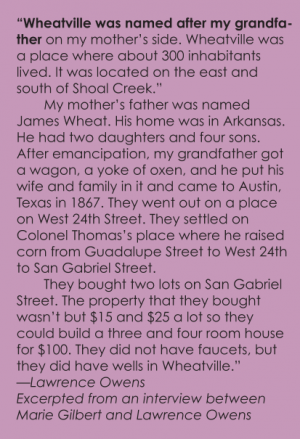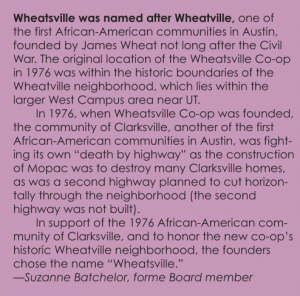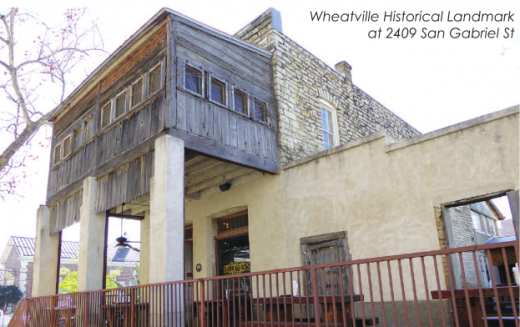How Did Wheatsville Get Its Name?
Wheatville
Edited from stories collected from the Austin History Center in 1996-2001
Wheatville, the first black community associated with Austin after the Civil War, was located at the western edge of Austin on former plantation land. The boundaries of Wheatville corresponded to present 24th Street to the south, 26th Street to the north, Shoal Creek to the west, and Rio Grande Street to the east.
 James Wheat, a former slave from Arkansas, brought his family to the area and founded the community in 1867. In 1869 he bought a plot of land at what is now 2409 San Gabriel Street and became Wheatville’s first landowner. Wheat raised corn in a site now bounded by Guadalupe, West 24th, and San Gabriel streets.
James Wheat, a former slave from Arkansas, brought his family to the area and founded the community in 1867. In 1869 he bought a plot of land at what is now 2409 San Gabriel Street and became Wheatville’s first landowner. Wheat raised corn in a site now bounded by Guadalupe, West 24th, and San Gabriel streets.
Wheatville residents worked mainly as domestics in white households, merchants in the community, and as semiskilled laborers in the Austin construction industry. A few blacksmiths lived in Wheatville, and some residents farmed and raised livestock. George Franklin, a former slave and a carpenter, purchased land at the site of present-day 2402 San Gabriel in 1869 and constructed a stone building with walls four stones thick. Now known as the Franzetti building, it became the center of the community as subsequent owners used it to house families, grocery stores, various other businesses, and churches.
Wheatville had about 300 inhabitants at its peak, which was probably around the turn of the 20th century. The community remained relatively isolated until Austin’s white population began to expand toward the more varied landscape and better drainage offered to the west. Wheatville began gradually changing to a neighborhood of Italian immigrants, and white residents surrounded the community. In 1905 Salvatore Perrone bought the Franzetti building and began operating a grocery store there. As land values in the area increased, the city passed restrictions on building quality and the raising of livestock within city limits.
In 1928 the city of Austin adopted a plan to locate all public facilities for blacks, presumably schools, recreation facilities, and health clinics, in East Austin. The plan’s stated purpose was to draw the remaining black inhabitants in western Austin to the east. The Wheatville school closed in 1932, and the community had practically vanished by the mid-1930s.
 The remaining sign of Wheatville is the stone building at 2402 San Gabriel. In August 1977 the Austin City Council declared the building a historical landmark. Wheatsville Food Co-op, founded in 1976, was named in memory of the community.
The remaining sign of Wheatville is the stone building at 2402 San Gabriel. In August 1977 the Austin City Council declared the building a historical landmark. Wheatsville Food Co-op, founded in 1976, was named in memory of the community.
BIBLIOGRAPHY: Austin American-Statesman, October 7, 1984. Austin History Center Files. Delta Sigma Theta Sorority, A Pictorial History of Austin, Travis County: Texas’s Black Community, 1839-1920 (Austin, 1972). Jacob Fontaine III and Gene Burd, Jacob Fontaine (Austin: Eakin Press, 1983). Vertical Files, Barker Texas History Center, University of Texas at Austin (Jacob Fontaine). Nolan Thompson
SOURCE: New Handbook of Texas, 1996
COURTESY: The Texas State Historical Association
Compiled by Raquel Dadomo from previously published stories and first-hand stories of people that were there.
